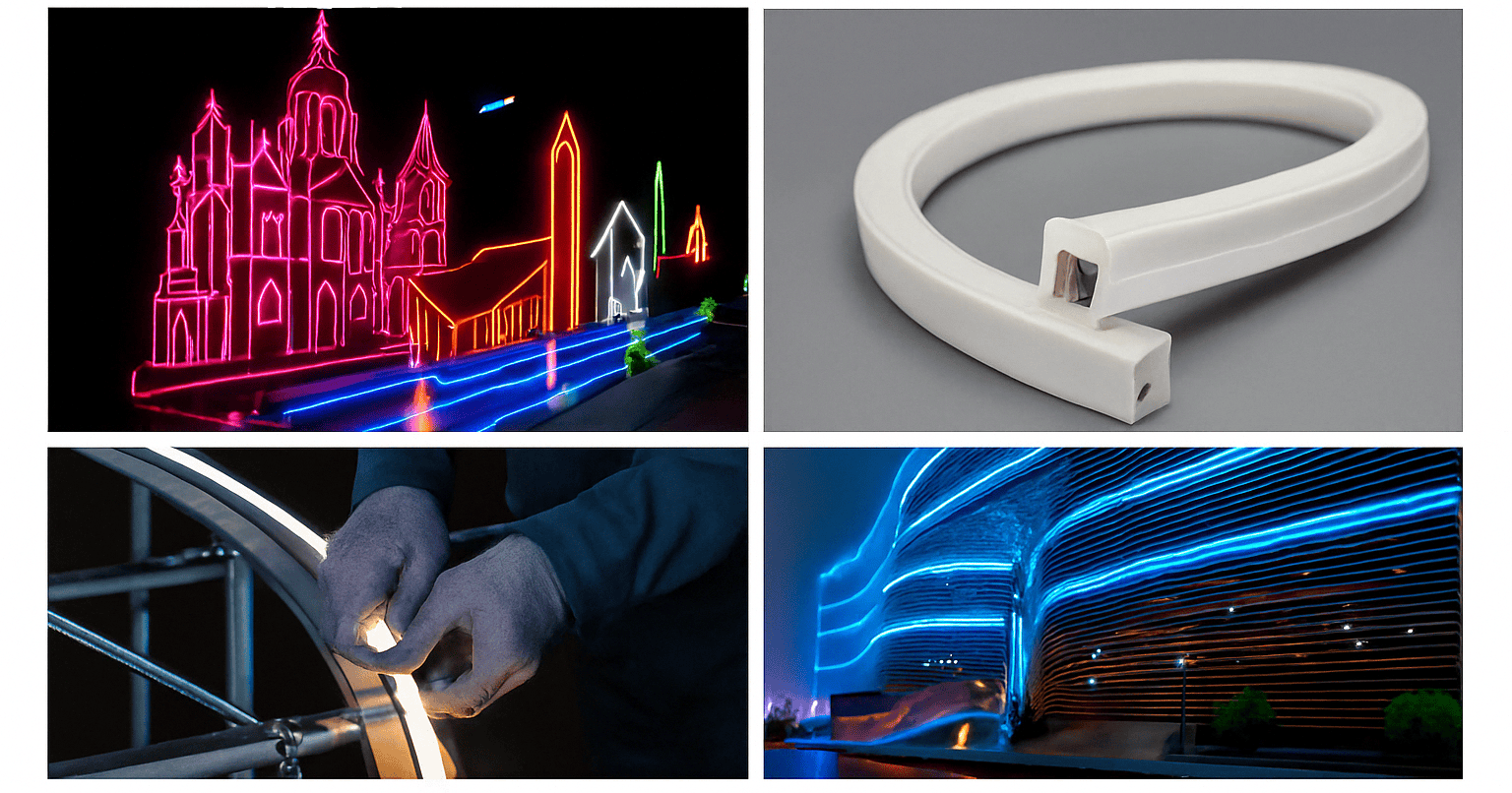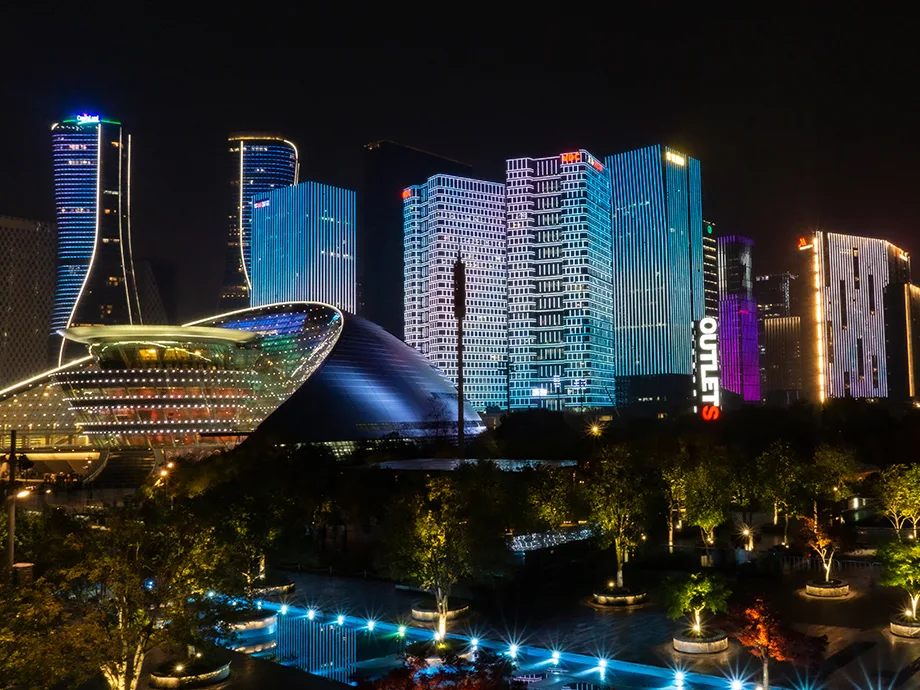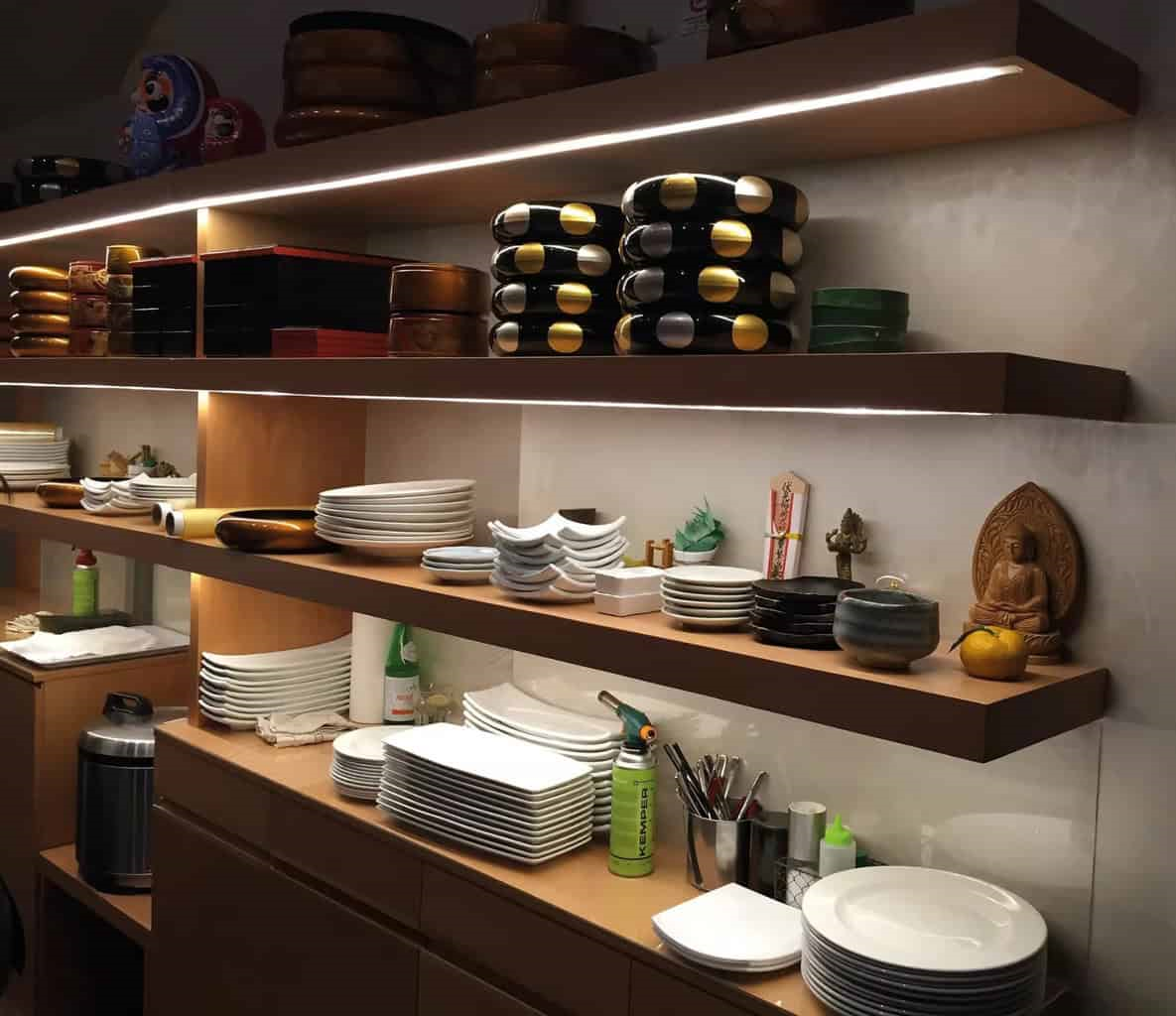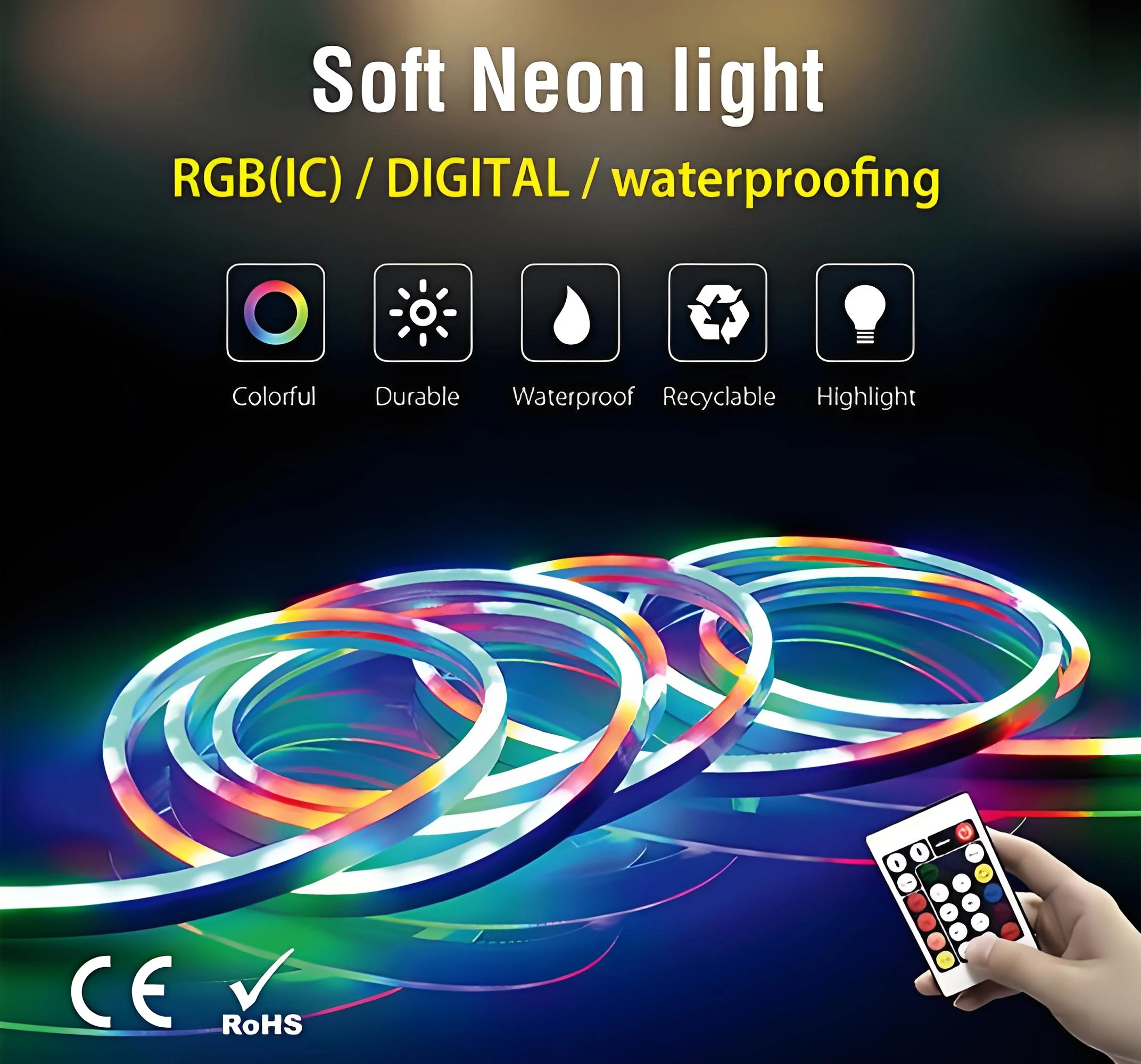Good architectural lighting can highlight architectural aesthetics, create a comfortable atmosphere, enhance spatial hierarchy, improve the visual experience at night, convey cultural connotations, and take into account energy saving and environmental protection, giving the city a unique charm and vitality.
Usually, designers personalize the design of building facades according to their own needs, which can improve their safety, visibility, and aesthetics. The creation of different colors also affects the aesthetics and mood of the space.
RGB LED neon flex strips play an important role in enhancing the aesthetics of architectural appearance and the city’s nighttime image with energy-saving and environmentally friendly, colorful, and dynamic lighting effects. Let’s talk about the control mode of the RGB LED neon curtain wall.
How to Control LED Neon Strips on Building Facades?
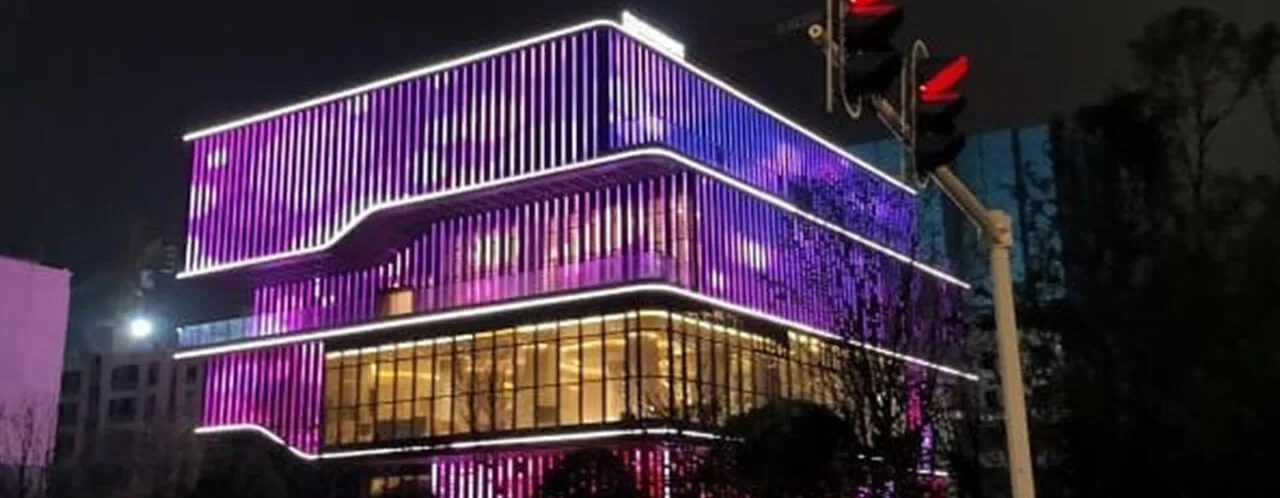
LED neon strips for building facades usually realize diversified effects through intelligent control systems. The core control device includes the main controller, such as a microcontroller, PLC, or special LED controller, which is connected to the lamps through wired (e.g., DMX512 protocol, SPI) or wireless technology (Wi-Fi, Bluetooth, ZigBee).
The system is paired with programming software to preset dynamic modes (gradient, blinking, text pattern), supporting real-time adjustment of brightness, color, and motion trajectory. Part of the system integrates light-sensing and time-control modules to realize automatic dimming or timed switching.
Large-scale projects using distributed architecture, the main controller to distribute the signal to the regional sub-controller, to ensure long-distance signal stability, and can be accessed through the network interface to the building management system or mobile remote control, both high efficiency and flexibility.
Building facade LED neon lights using DMX control has significant feasibility. The DMX512 protocol supports multi-channel, high-precision dimming and color control and can accurately achieve dynamic gradient, zone linkage, and other complex lighting effects to meet the needs of artistic expression of the building facade.
Its standardized architecture facilitates access to existing lighting control systems, supports large-scale lamp and lantern networking, and a single line can be connected to 512 channels, with strong scalability. The DMX controller can be programmed to adjust the lighting mode in real time, with fast response speed and excellent synchronization.
DMX control needs to be equipped with professional decoders to convert signals, long-distance transmission needs to be installed with signal amplifiers, the system needs to be lightning-proof and waterproof in design to adapt to outdoor environments, and pre-planning needs to be reasonable for the distribution of the address code and line layout. Overall, DMX technology is mature and cost-controllable and is the preferred solution for architectural dynamic lighting systems.
As a DMX LED strip manufacturer, SignliteLED specializes in producing DMX LED neon strips for architectural lighting, with internal integration of various UCS512 IC chips such as UCS512C4 (256 levels of grayscale), UCS512H4, UCS512H5, UCS512H6 (65,536 levels of grayscale), and other UCS512 IC chips, which can be directly connected to the main DMX control.
This series of flex LED neon strips has precise dimming (0.1% accuracy), full color mixing, and seamless synchronization control. The core products include DMX colorful strips, pixel strips, and waterproof series, which are widely used in stage performances, architectural landscapes, commercial spaces, and smart homes.
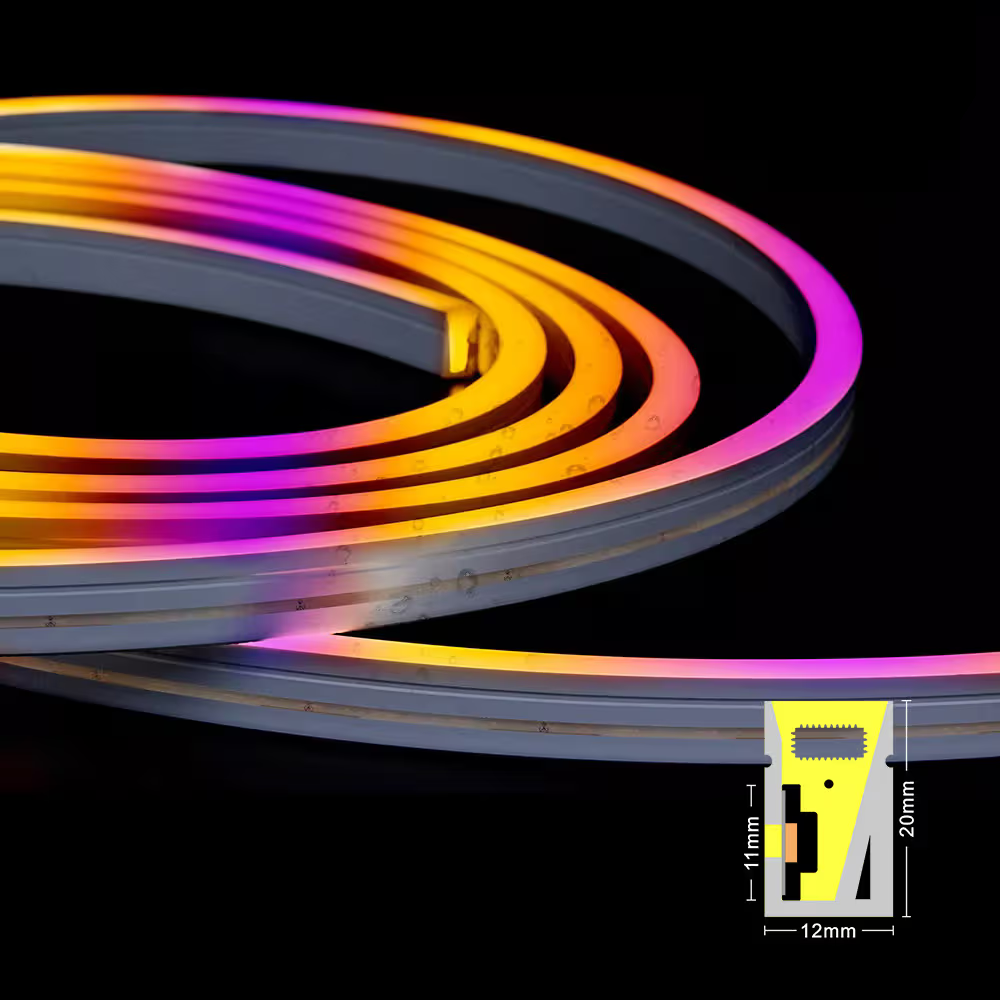
Side Bend S1220 Silikonowa adresowalna taśma neonowa LED do oświetlenia architektonicznego, ściennego i elewacyjnego
Napięcie wejściowe: DC24V
Watt: 12W/m@RGB, 19W/m@RGBW
ILOŚĆ diod LED: SMD5050 60 diod LED/m
Color: RGB/RGBW(2700K-6500K)
Typ sygnału: SPI/DMX512
IP Grade: IP65/IP67/IP68
Cable Entry: Front/Side/Bottom
Minimalna średnica gięcia: 100 mm
Długość cięcia: 100 mm
Długość: 5 metrów/rolka
What is the difference between DMX512 and SPI control LED neon flex?
1. Protocol Characteristics
DMX (digital multiplexing protocol), designed for stage lighting, based on the RS-485 standard, supports long-distance transmission (up to 1200 meters) and 512-channel control, and the use of a master console for unified management of multiple devices. SPI (Serial Peripheral Interface) is a short-range, high-speed synchronous communication protocol that uses master-slave architecture through the clock signal synchronization of the data transmission, suitable for small-scale device control.
2. Application Scenario
DMX is suitable for professional lighting projects, such as building facades, stage lighting, and other large-scale systems, and can be connected in series with hundreds of neon strips to achieve complex dynamic effects. SPI is mostly used for simple and low-cost LED neon strips and small decorative lamps driven directly by the microcontroller in real time, but with limited scalability.
3. Performance and complexity
The SPI transmission rate is high (up to the MHz level), but the anti-interference ability is weak, and the wiring needs to be short. The DMX transmission rate is low (250 kbps), but through the differential signaling anti-interference, it supports long-distance stable control, and it needs to configure the decoder and address allocation.
SPI has high-speed transmission in short distances, but there may be signal attenuation in long distances; DMX uses differential signals with strong anti-interference ability, suitable for long distances, such as several hundred meters, but the speed may not be as fast as SPI.
Summary: SPI is suitable for low-cost applications, such as decorative neon strips or small displays, because it is simple to control, low cost, and suitable for short distances and small projects. DMX is highly reliable and scalable to meet the needs of the professional level, but the cost and complexity of the setup are higher. Examples include concerts, theaters, or neon lights on the exterior of a building because it can handle more devices and longer distances.
What are the applications of DMX512 and SPI LED neon strips?
DMX512 and SPI are two different control protocols, each with its own application scenarios and advantages in LED neon strips (or lighting systems). Below are their typical applications and differences.
1. Application of DMX512 protocol
DMX512 is a standard protocol widely used in stage lighting, architectural lighting, and other professional fields, with the following characteristics:
Long-distance control: Based on the RS-485 electrical standard, it supports the longest transmission distance of 1200 meters (a repeater is required). A single bus can be connected in series with 512 channels (i.e., control 512 parameters) and can be expanded to thousands of devices through sub-controllers.
Zalety: strong anti-interference ability, suitable for complex electromagnetic environments; mature protocol, high device compatibility; can be programmed through software (such as LightKey or Madrix) for complex lighting effects.
Typical application scenarios:
Stage lighting: control multiple groups of light color, brightness, and dynamic effects, such as concerts and theater performances.
Building facade lighting: dynamic light show of large buildings, such as color gradient and pattern switching.
Oświetlenie krajobrazu: lighting system for parks and bridges, supporting remote synchronized control.
Przestrzeń komercyjna: lighting atmosphere design of shopping malls and exhibition halls, realizing partition control.
2. Application of SPI protocol LED
SPI (Serial Peripheral Interface) is a short-distance, high-speed serial communication protocol, commonly used to control point-to-point LED strips (such as WS2812B, SK6812, and other chips) with high-speed refresh rates (such as more than 30 fps), suitable for dynamic animation. Control multiple LEDs through one data line, simplifying wiring.
Zalety: Simple control, no need for complex sub-controller; low cost, suitable for small-scale projects; flexible to realize gradient, rainbow, breathing lights, and other delicate effects.
Typical application scenes:
Art installations: small interactive light sculptures, wall pixel paintings.
Interior decoration: home backlighting, window strips, holiday decoration (e.g., Christmas tree).
Electronics: RGB keyboard backlighting, smart home ambient lighting.
Advertising display: low-resolution LED screen, text scrolling effect.
Wearable devices: dynamic lighting design for light-emitting apparel and accessories.
Why choose DMX512 RGB neon for façade lighting?
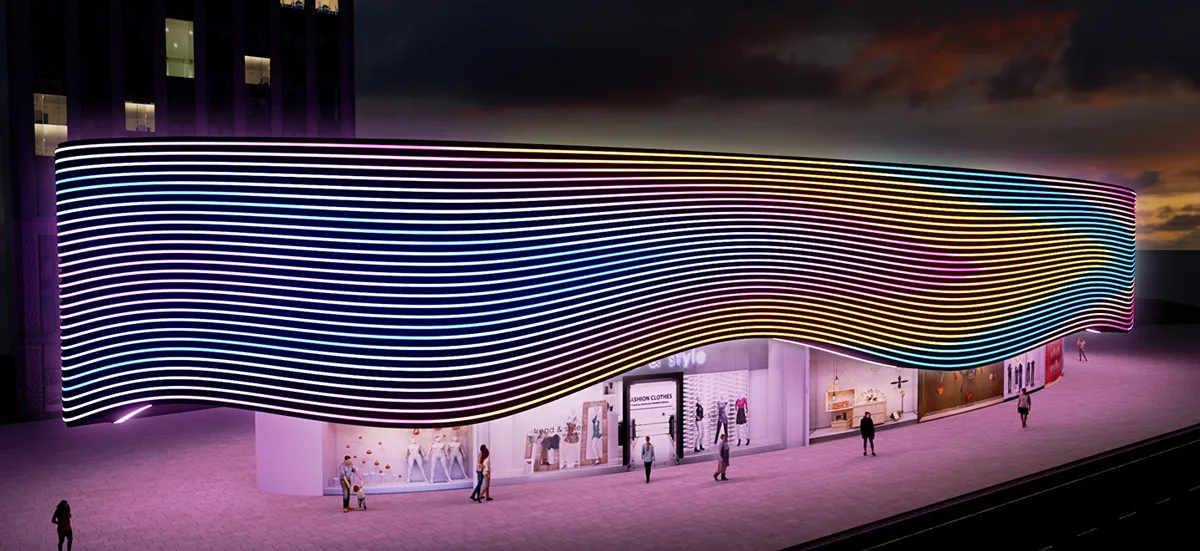
DMX512 RGB neon is the preferred solution for architectural façade lighting, mainly because it has four core advantages:
1. Precise control capability: DMX512 protocol supports 512 channels of control, which can realize independent programming of each fixture to meet the demand for refined light effects of complex architectural structures.
2. Dynamic color performance, RGB three-color mixing technology with PWM dimming, can present 16 million kinds of color gradients and dynamic effects, significantly enhancing the architectural artistic expression.
3. Strong system compatibility; can be seamlessly docked with the BIM system and intelligent building platform to achieve intelligent linkage of lighting scenes and building functions.
4. Energy-saving and environmentally friendly features, the use of LED neon tubes (more than 70% energy savings compared with traditional light sources), and support for time-sharing control strategy.
These technical features make it possible to shape the iconic city night scene while taking into account the economics of energy efficiency management and long-term operation and maintenance, becoming the preferred solution for modern architectural lighting design.
How to control the LED neon strips with DMX512?
1. Control system composed of PC and DMX512 controller
1) DMX512 controller in connection with the PC, the PC side can carry out the effect design and configure different parameters for different effects, such as the length of the demonstration, the speed of the demonstration effect, etc., which can be pre-set.
2) Console dial control for all channels: the user, through the controller on the button for program selection, presentation speed settings, etc., can have a variety of modes of control, such as running, running water, color gradient, etc.; can be turned on and off; or can adjust the brightness of the individual LED lamps, and so on.
3) DMX controller according to the user’s settings, effect demonstration, that is, send the effect data to the RGB neon strip to achieve the demonstration effect. Multiple controllers can work in parallel, and they are synchronized with each other by synchronization signals.
PC and DMX Combined Ckontrola Cobwód Diagram
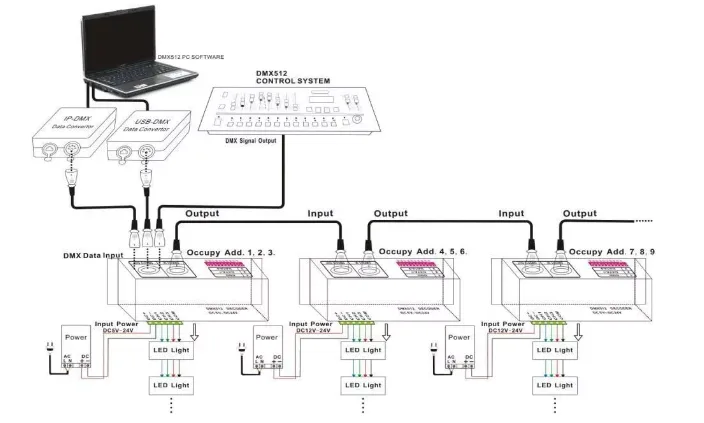
The outdoor architectural lighting control system composed of a PC and DMX512 controller has significant advantages. It realizes centralized programming and remote control through PC software and supports dynamic lighting effect design, scene presetting, and timing tasks, which greatly improves management efficiency.
The high-precision dimming (0-255 levels) of the DMX512 protocol can delicately control the brightness and color of LED lamps and achieve smooth gradients and complex lighting art performances. Thousands of fixture nodes can be controlled through relay expansion to meet the needs of large building groups. In addition, the real-time monitoring and fault feedback function is convenient for maintenance, which is the preferred solution for smart city landscape lighting.
2. DMX512 directly controls DMX512 LED neon stripes
The DMX512 controller can directly control the DMX512 protocol-supported LED neon strip, provided that the strip has a built-in DMX decoder chip or is equipped with an external decoder.
The controller transmits data via RS-485 differential signals, and each strip needs to be set up with an independent address code to respond to the commands so as to achieve precise control of brightness, color, and dynamic effects. Shielded twisted-pair cable (such as XLR or RJ45 interface) should be used for connection, following the master-slave architecture in series wiring, with a 120Ω terminal resistor at the end to ensure signal stability.
The system supports 512 independent channels, can be extended to control multiple sets of light strips, and is widely used in stage lighting, architectural landscapes, and other scenes. The data line should be 2PIN-3PIN. Usually LED lights are used for DMX512 control directly connected to the decoder chip: TM512, SM19522PHG, UCS512, SM17500P, H1512A, and so on.
DMX512 Direct Control LED Strip Light Wiring Diagram

This connection method is generally applicable to DMX512 controllers, is suitable for architectural scenes that require complex dynamic lighting effects, and its high-precision dimming and synchronization control capabilities can meet the smooth gradient of large building facade light shows, multi-dimensional light effect linkage of the theater stage, as well as the precise projection needs of museum exhibition lighting. Through the preset program or instant control, it can create rich artistic light and shadow space, taking into account the energy-saving management and visual shock effect.
3. DMX converts SPI signals to control LED neon spodróże
First of all, we have to figure out the basic concepts of DMX and SPI. DMX is usually used for stage lighting and is a digital control protocol, while SPI is a serial peripheral interface, commonly used in microcontrollers and peripheral communication. LED light strips may use SPI protocol, such as the WS2812B, but it may require a specific data format.
DMX is an asynchronous transfer, whereas SPI is synchronous and requires buffering or real-time processing. Firmware will also need to be written to handle the data conversion, or an off-the-shelf conversion module will be used. The user may need an intermediate controller that parses the DMX signal and sends it to the neon LED strip via SPI.
All this sounds a bit complicated, but now you just need to buy the “DMX-SPI decoder,” as shown below, to convert DMX signals to SPI signals. The DMX-SPI LED decoder parses the signals from the DMX controller and converts them to a format suitable for SPI communication. In this way, each addressable LED can display a specific color and brightness based on the DMX512 data.
DMX to SPI LED Strip Wiring Diagram
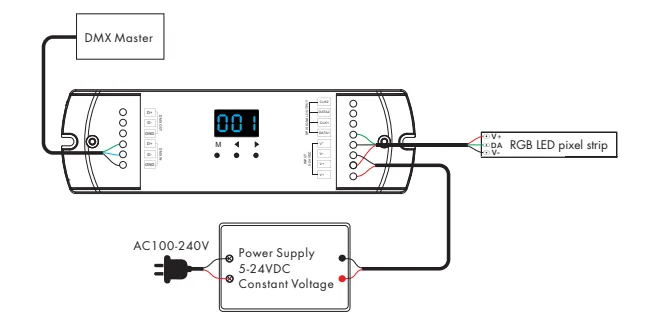
The choice of control system for LED neon signage on building facades depends on the needs and scale of the project. DMX512 protocol is the preferred choice for large-scale dynamic lighting projects due to its long transmission distances (up to 1,200 meters), independent control of multiple channels (512 channels/lines), and proven compatibility with stage lighting. The SPI protocol is commonly used for pixel-level control of LED display screens, but the transmission distance is short (generally <10 meters) and needs to be extended with a repeater, applicable to small and medium-sized precision animation projects. From a comprehensive point of view, DMX has the highest proportion in building facade control (about 60%-70%), and SPI is mostly used in art installations or small projects.
By analyzing and discussing the above three wiring methods, we hope to help you understand the application differences of their different wiring! If there are specific project requirements, you can further explore the optimization scheme.
FAQ
Generally speaking, high-quality LED neon strips are UV resistant, minimizing the risk of fading when exposed to sunlight. SignliteLED’s neon strips are all made of silicone material, all of which can be used outdoors without turning yellow or brittle.
Generally speaking, high-quality LED neon strips are UV resistant, minimizing the risk of fading when exposed to sunlight. SignliteLED’s neon strips are all made of silicone material, all of which can be used outdoors without turning yellow or brittle.
LED flexible neon strip is safe to use on facades because it is designed to be moisture resistant. However, it cannot be soaked in water. If you want to immerse it in water, you need to choose an IP68-rated LED neon strip.
LED flexible neon strip is safe to use on facades because it is designed to be moisture resistant. However, it cannot be soaked in water. If you want to immerse it in water, you need to choose an IP68-rated LED neon strip.
Most of the LED neon strips use stainless steel fixings for easy installation.

